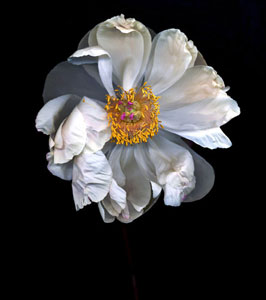Ever
since Marcel Duchamp mounted the front wheel of a bycicle
onto a bar stool, the anarchic use of everyday technologies
has been part of the standard repertoire of Modern Art. Usually
such works question our perception by distorting reality.
The flower images by the New York artist Katinka Matson are
different for their exactness and completeness: the surreal
aura of her pictures come from their enormous clarity. The
flowers seem to radiate from the inside and the details are
recognizable into the last fiber as though they were being
viewed under a magnifying glass.

| Scanner
Flowers |
Photo:
Katinka Matson
|
Katinka
Matson may not be the first to experiment with this approach
to imagery. In the 60s, photo-realistic painters played
with this kind of hyper-realism in much the same way as
photographers of today such as Andreas Gursky or Loretta
Lux.
What's
new, however, is the technology that Katinka Matson uses
to make her pictures. Instead of oilpaints or a camera
she uses a regular scanner. And because the light scanning
of such an office machine eliminates even the easiest distortion,
she develops a naturalistic effect, which questions our
way of seeing, because our eyes have long adjusted themselves
long ago to the distortions of photo and movie cameras.
Science
historian George Dyson described the effect of Katinka
Matson's pictures: "Visual processing (in humans and
other organisms) is characterized by layers: not only the
layers in the retina, behind the retina, in the visual
cortex, and finally in our consciousness and our culture
as we interpret the ultimate results. There are also evolutionary
layers, and the lensless, scanner-like visual system of
the insect still lingers, unseen but essential, in some
of those layers between light
and brain. One of the reasons—besides sheer artistry—that
Katinka Matson's work resonates so strongly with us is
that the insect-like vision that results from scanning
direct-to-CCD runs so much deeper in us than vision as
processed through a lens. By removing the lens, Katinka's
work bypasses an entire stack of added layers and takes
us back to when we saw more by looking at less."
It
began with a coincidence. While scanning a regular photo
Katinka Matson put a bunch flowers on the scanner. "I
was rather frustrated that day. But the very first
flower scans had already inspired me," she said. She
has no idea if she was the first, or only, artist to experiment
with this new technology. But she was the first to perfect
the art of scanning to the point of gaining recognition
as an artist. In 2002, The New York Times Magazine included
her work in its annual year-end edition of the big ideas
of the year.
For the past five years she has experimented with techniques and materials,
until she found the perfect combination of creating images through her scans,
working on them with Adobe Photoshop, and presenting them as Iris prints on
water color paper, which are mounted on aluminum. Because Iris prints are limited
as to size, and are, in addition, extremely sensitive, in her newest series
of white spider flowers, she uses a new digital printing process on large canvases
which adds even more power to the painting-like structure of her images. She
normally makes thirty forty different scans from a set of flowers, before she
finds an image that interests her. And recognizing the right state of the dessication
of the flower can take days of observation. "Fresh flowers are pretty," she
says, "but they only become interesting when they begin to show the first
signs of withering."
Katinka
Matson's "Spiders" is on exhibition in Munich
this week, her first work on canvas, in the context of
the Bitfilm Festival for Digital Media in the Bundesgartenschau
(German National Garden show). A slide show projection
of earlier work is also being presented.
ANDRIAN
KREYE
Copyright © sueddeutsche.de GmbH/Süddeutsche Zeitung GmbH
[Original
German Text]
|
